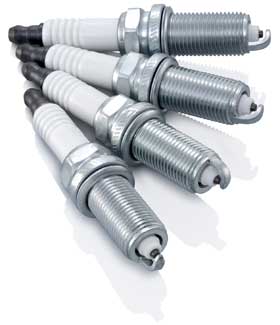Compiled by Photonics Spectra staff
Automakers are now one step closer to replacing spark plugs for internal
combustion engines with laser igniters for cleaner, more efficient and more economical
vehicles.
Lasers have been discussed as a promising alternative ignition
source for efficient internal combustion engines because they promise less pollution
and greater fuel efficiency. Until recently, it was difficult to make small, powerful
lasers that could focus light to ~100 GW/cm2 with short pulses of more than 10 mJ
each, needed to ignite combustion.

For more than 150 years, spark plugs have powered internal combustion engines. Now,
automakers are one step closer to replacing the plugs with laser igniters, which
will enable cleaner, more efficient and more economical vehicles.
Scientists from Japan’s National Institutes of Natural Sciences
overcame this problem by making composite lasers from ceramic powders. They heated
the powders to fuse them into optically transparent solids, and embedded metal ions
in them to tune their properties. Ceramics are easier to tune optically than conventional
crystals and are much stronger, more durable and thermally conductive, enabling
them to dissipate the heat from an engine without breaking down.
The research team built its laser from two yttrium aluminum gallium
segments, one doped with neodymium, the other with chromium. The two segments were
bonded together to form a powerful laser only 9 mm in diameter and 11 mm long. The
composite generated two laser beams that could ignite fuel in two separate locations
simultaneously, producing a flame wall that grows faster and more uniformly than
one lit by a single laser.
Not strong enough to light the leanest fuel mixtures with a single
pulse, the laser can, however, inject enough energy to ignite the mixture completely
by using several 800-ps-long pulses. It was tested at 100 Hz – a commercial
automotive engine will require only 60 Hz.
Although promising, the system is not yet being installed into
automobiles. The team is working on a three-beam laser that will enable even faster
and more uniform combustion. Supported by the Japan Science and Technical Agency,
the work was presented at CLEO 2011.